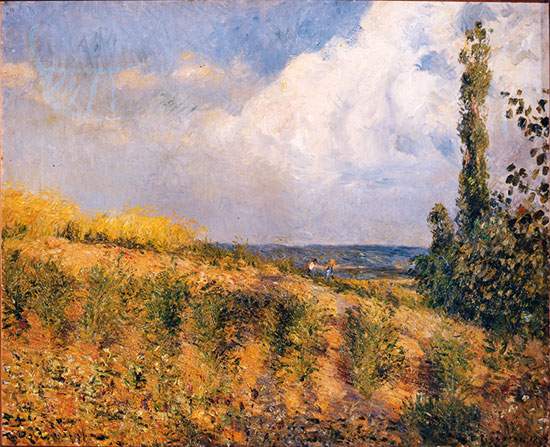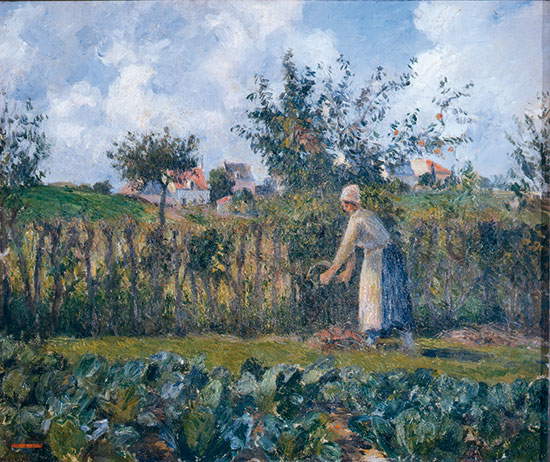The arrival ofFrenchImpressionism, in Florence and Italy, occurred during a very specific occasion: the Florentine Promotrice exhibition of 1878. The Promotrice was a society, established in Florence in 1843 as the Società Promotrice delle Belle Arti (and still in existence today, under the name of Società delle Belle Arti - Circolo degli Artisti “Casa di Dante”), whose purpose was to support artists and spread awareness of their works, with exhibitions being held regularly in its premises and where artists exhibited all their novelties. The Promotrice was, for example, instrumental in introducing Italy to the Macchiaioli movement, which would later dominate the art scene in Florence and the country as a whole in the late 19th century.
In 1878, French Impressionist painting was still almost completely unknown in Italy, despite the fact that Impressionist painters had already been active for a few years: there were few connoisseurs of their art in our country. Prominent among them, however, was a personality who was instrumental in the arrival of Impressionism in Italy: Diego Martelli (1839 - 1896), an art critic, “theoretician” of the Macchiaioli, and up-to-date collector, who resided in Paris for some time. In the French capital, Martelli used to frequent the Café de la Nouvelle Athènes, a meeting place for artists and intellectuals, and thanks to such frequentation he had the opportunity to come into contact with the major Impressionist painters, and even to make friends with some of them. The artist to whom he probably bonded most was Camille Pissarro (1830 - 1903), towards whom the critic had a strong admiration, so much so that he tried everything to bring some of his canvases to Italy: Diego Martelli, on the one hand, had taken to heart the fortunes of the painter, who was going through a period of very strong economic difficulties, and on the other hand he had sensed the similarities that linked the Macchiaioli painters to the Impressionists, and was therefore intent on bringing out such identities of views in Florence as well.
Thus, Martelli purchased two landscapes from Pissarro and convinced him to send them to Florence. In a letter dated September 1878, Diego Martelli wrote to the Macchiaioli painter Francesco Gioli as follows, “I have been so busy that I have persuaded my friend Pissarro to send to the exhibition of the Promotrice (in Florence) two paintings, one more impressionistic than the other.... Given, however, the strange quality of this painting [...] friends do not abandon these canvases without a fight.... I hope that it will not be useless for you people to see the strange way by which these artists try to achieve effect, but that it will raise much discussion among you people. It need not be said that Pissarro, in view of his phenomenal misery, and his modest character, is ready to release the paintings for sale at a very small price, and in case the strange hypothesis of a benefactor occurs, do not forget to offer and have him offer.” The two paintings arrived punctually in Florence in November 1878: they were two small canvases known as La taille de la haie (“The Cutting of the Hedge”) and Paysage - L’approche de l’orage (“Landscape - The Approaching of the Storm”). They were both exhibited, as mentioned at the beginning of the article, at the Florentine Promotrice exhibition. Both with their price alongside: probably Martelli was counting on reselling them, as can be guessed from the letter to Gioli, to further help Pissarro.
 |
| Camille Pissarro, Landscape-The Approaching Storm (1878; Florence, Gallery of Modern Art, Palazzo Pitti) |
 |
| Camille Pissarro, The Cutting of the Hedge (1878; Florence, Galleria d’Arte Moderna di Palazzo Pitti) |
The reception, however, was not what Diego Martelli would have hoped for his friend’s Impressionist works, and the judgments given by the Florentine milieu were negative, indignant, and sometimes even contemptuous. Giovanni Fattori would say, disdainfully, that compared to the Impressionists “we were further ahead.” Francesco Gioli himself would react with pungent irony: if, in July of that same year, Martelli had called Pissarro a “nice Impressionist and one of the strongest of the brigade,” Gioli, after seeing his paintings, said that “Pissarro is a strong artist, I believe it but I do not see it from the paintings he sent here.” And Gioli would not spare his fierce sarcasm even toward Silvestro Lega, who along with Telemaco Signorini was the only one to appreciate Pissarro’s paintings: in reference to the eye disease that had affected the Romagna painter, Gioli said that “Lega alone, in his quality of semi-blind, approaches Signorini in admiration.” But, in essence, what is it that almost all the Macchiaioli reproached Camille Pissarro’s paintings for? There are, of course, several similarities between Macchia painting and Impressionism, but also many differences: the Macchiaioli also looked to tradition and, as painters mostly from Tuscany, often based their works on traditional drawing, also gave more plastic volumes to their figures, and outlined their subjects with sharper, more defined contours. A more rarefied, elusive, and less defined painting such as Pissarro’s, therefore, could not have been very close to the taste of the Macchiaioli. Lega and Signorini, on the other hand, showed lively enthusiasm precisely for the borderline daring results of the Frenchman’s painting, recognizing in it a modernity and originality that were not indifferent.
Martelli, however, did not give up, and wanted to express to Giovanni Fattori in person his disappointment at the reception that painters in the Tuscan sphere had reserved for Pissarro’s two canvases. From Paris, where the critic was staying, he wrote the Leghorn painter a rather harsh letter, excerpts of which I quote: “I fell from the clouds when I read your judgment on Pissarro’s works, since if there is anyone among us who in certain paintings resembles him more than all the Impressionists, it is you. So true is it that here your studies next to things by Pissarro and others of the same genre stand in very good company. That that painting does not please Lemon and Bruzzi, is understandable; because both of these artists always enclose in a very hard outline, like that of an inlay their colors, and especially, Bruzzi; but you who have painted beautiful things, which were exhibited in a charity fair in Via Sapienza (certain villas with olive trees in Fauglia) in which everything resulted by stain of color, I do not understand how you cannot find anything in the paintings of Pissarro. [...] I could understand the remark you make about color, as false, if you had never been in France or if you had been there in winter. But if you have not traversed the French countryside sleeping, and you remember it, you will say instead that, as a local color, nothing more exact can be desired. [...] What was the painting you had at the Promotrice last year, The Woodcutters, if not an impression? What was the Charge sold in Turin, if not an impression ? [...] More I tell you, if the Impressionists are less advanced than you, so much the better for not being in a position to stop, but rather to continue.” It was necessary, therefore, to run for cover, and try to present Impressionist painting in Italy in a somewhat more thorough way.
So it was that Diego Martelli, in 1879, organized two lectures in Livorno in the premises of the local Circolo Filologico, precisely with the aim of talking to the public about Impressionist painting. The lectures he gave in the two separate speeches later converged in a short essay, published in 1880, which to this day can be regarded as the first critical contribution in Italy on the Impressionists, as well as the first tout-court contribution by a non-French critic. Among the final passages of the lecture, during which Martelli had spoken about the achievements of Manet, Degas and colleagues, there is one that encapsulates the critic’s assessment of the artistic current that changed the history of art: “Impressionism is not only a revolution in the field of thought, but it is also a physiological revolution in the human eye. It is a new theory that depends on a different way of perceiving the sensation of light, and of expressing impressions. Nor did the Impressionists first fabricate their theories, and afterwards adapt paintings to them, but on the contrary, as always happens in discoveries, it was the paintings born of the unconscious phenomenon of the eye of men of art which, studied, afterwards produced the reasoning of philosophers.” This was the first official recognition of Impressionist art in our country: from there on, critics and the public would show an increasingly open attitude.
Warning: the translation into English of the original Italian article was created using automatic tools. We undertake to review all articles, but we do not guarantee the total absence of inaccuracies in the translation due to the program. You can find the original by clicking on the ITA button. If you find any mistake,please contact us.